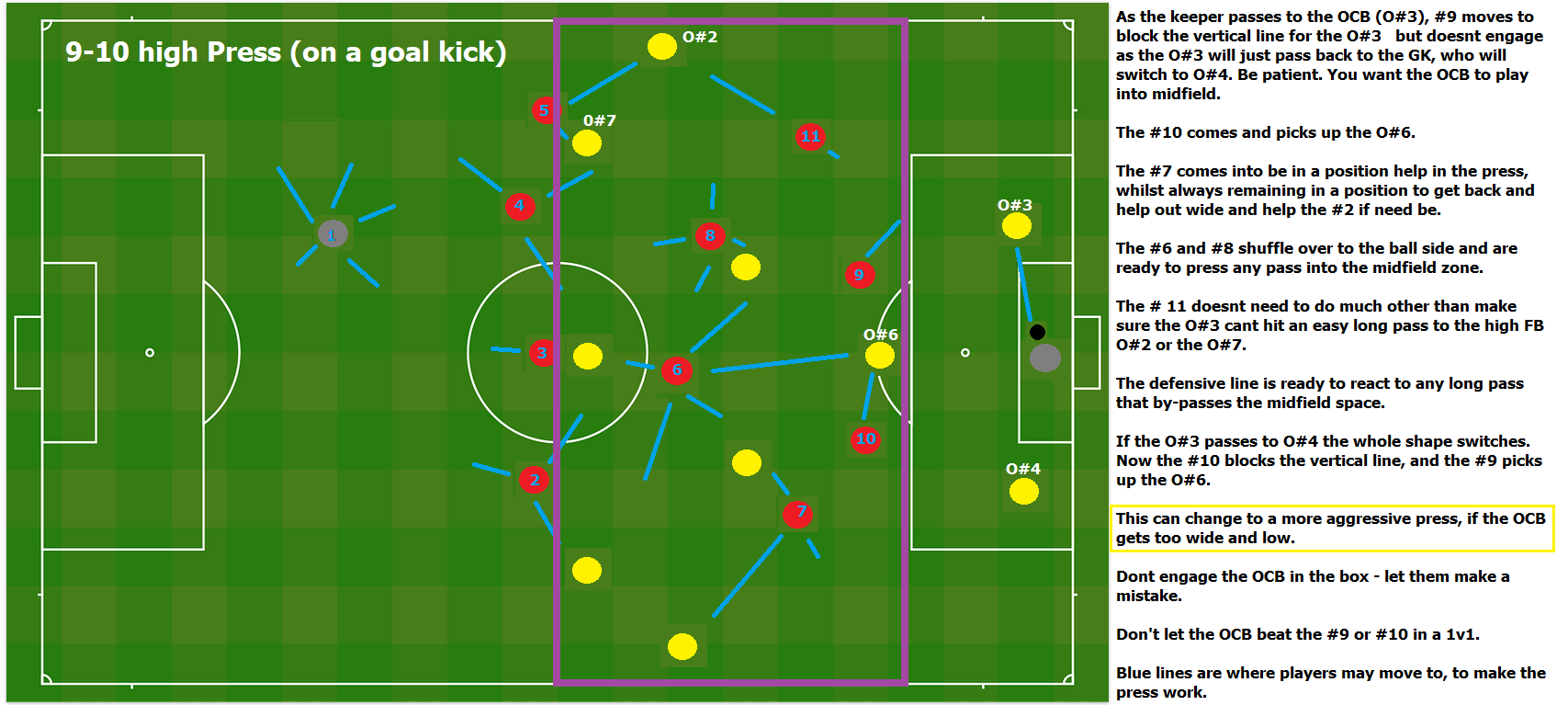High Flat #9 - #10 Block
Note :
- Flat - Means there isn't a #9 - #10 pivot blocking the OCB from playing forward &
- High - Means the press is high up the pitch (100% into the oppositions half).
A '#9-#10 high press' is almost identical to the 'Flat Mid Block' except it is set up near the edge of the opposition box.
- As in a flat mid block, when the ball is played forward into the midfield space there is an aggressive press (this is the trap).
- The defensive line and goal keeper are also very switched on to the ball over the top.
- This is used when the opposition want to play out from a goal kick, or when the opposition have got caught in possession in very low positions.
- The key thing is that you let the OCB have the ball and you give him one forward pass (to the O#6, OFB, O#8, O#9 etc)
High Flat #9 - #10 Block on a Goal Kick

The idea in this block is to not necessarily prevent the OCBs from being able to play the ball forward but there is a strong attempt to force the CB into a predictable pressabe pass.
- The OCBs have the option to hit it long forward passes (but the Goal keeper had this option, so you haven't given them anything they not did already have).
- The OCBs will be wider than the goal keeper, so if the ball is hit long, we should have a numbers advantage along the vertical lines and need to be very competitive in our attempts to win the ball back.
- The OCBs can also pass sideways and backwards. That's OK. Hopefully, the OCBs lose their patience and play a risky forward passes.
In the pic below, you can see that when the OCB has the ball,
- Our #9 has moved to 'ball vertical line' and prevents easy forward passes.
- Our #10 has moved into the O#6 space so that the O#6 isn't an option.
- Our #6 and #8 have tightened up on the opposition midfield space, so a pass into higher midfield positions is not an option.
- Our Ball side full backs gets tight so a pass to the high OFB is not an option.
- One of our #CBs gets tight.
- Our other #CB covers.
- Our non-ball side FB tucks in, leaving the far side OW free.
- Our #11 (Ball side winger) prevents an easy pass out for the O#3.
- Our #7 (Far side winger) tucks into the midfield space.

The block starts :
The block starts on the #6 line (not the edge of the box). This will discourage the Goal keeper hitting long and encourage them to use their center backs.
The Goal keeper passes to the OCB
The process starts with an opposition center back (OCB) receiving the ball, and while the ball is rolling, the #9 moves to a position on the edge of the box that stops the OCB from playing forward easily. Do not press the CB while the CB is in the box, but as soon as the ball leaves the penalty box, there is an intense press. The #9 cannot get beat in a 1v1 moment. Allow sideways and backwards play
The #9 and #10 switch roles constantly
While the 9 is occupying the OCB, the 10 is in the oppositions 'O#6' space and stopping the OCB playing into this space.
When the OCB on the ball passes to the other OCB, the #9 and #10 switch roles. [This switch needs to occur quickly, while the ball is rolling, so the OCB now on the ball doesn't have any easy forward options.]
The #9 & #10 need to work hard.
The #9 & #10 need to work hard to make this work. Maybe the wingers [or #6/#8] can swap roles to share the work if necessary.
Game Management
There is a risk to this. If the oppositions bangs it long then the defensive line will be under pressure to not make a mistake or get caught out. So if you were winning then you might not use this high press. Especially if the keeper is just going to bang it long. It maybe better to be lower and see if the goal keeper can use the OCBs and see if the OCBs play, instead of just banging it long.
It is not unbreakable
It is not an unbreakable block. Clever positioning and movement form OCB's and O#6 can break this block.
If it fails
As always if the block / trap breaks down the Drop & Block to a lower position.
When to change to a full on squeeze
If the OCB stuffs up in some way, then this high press may change into a full on squeeze. This is looked at later in this series.